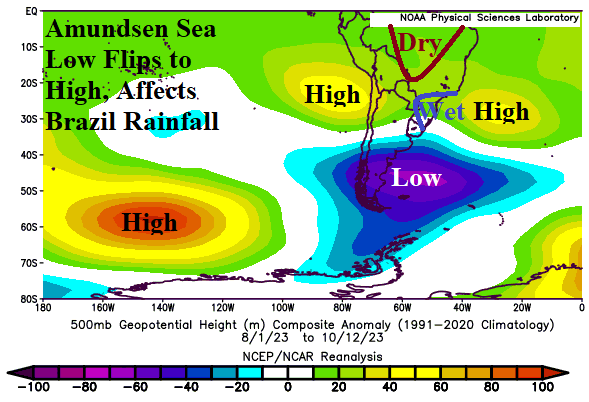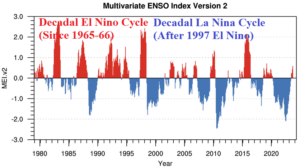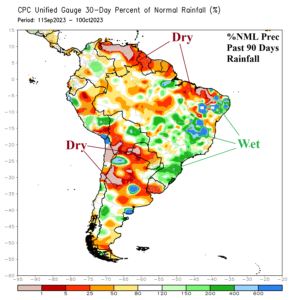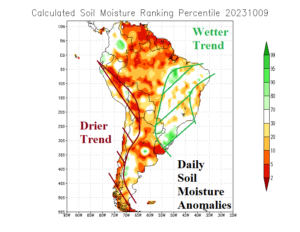
Why is Global Atmospheric Angular Momentum Negative Given El Nino Presence?
10/08/2023, 12:11 pm EDT
Climate Forecast Factors for South America Into Mid-Summer
10/16/2023, 8:52 am EDTA review of long-term (ENSO) climate for Brazil and projections for NOV/DEC 2023 plus JAN/FEB 2024. Central Brazil drought emerges, fades late summer. Southeast Brazil rains help long-term soil moisture deficits/low river levels.



Fig. 1-3: Multivariate ENSO index for 1979 to 2023 (so far) plus the most recent El Nino and La Nina long-term rainfall cycles determined by ENSO.
Discussion: As a reminder, the long-term ENSO cycle shifted to La Nina in the late 1990’s and remained in-place through 2022 (Fig. 1). An El Nino has formed but is not anticipated as a sign of ending of the long-term cold ENSO cycle. The long-term ENSO shift has produced a climate change across Brazil. During the warm ENSO cycle (1965-1997) the Brazil climate was generally wetter than normal (Fig. 2). However, during the past 2-3 decades, the cool ENSO cycle has caused the Brazil climate to shift dry (Fig. 3).
Interestingly, strong El Nino events initiated both the long-term warm ENSO cycle in the middle 1960’s and the long-term cool ENSO cycle in the late 1990’s. Long-term ENSO cycles last, on average, 3-4 decades. If El Nino 2023-24 is unusually intense (not expected), there is a chance that a reversal to the long-term warm ENSO cycle may initiate. In Brazil, the long-term drier than normal/cool ENSO cycle pattern causes increased susceptibility to drought and low river levels.
A wetter tendency associated with El Nino has emerged during the past 90 days in much of Brazil (Fig. 4) and similar too 1966-1997 warm ENSO climatology. As a result, soil moisture anomalies are trending wetter in Brazil (Fig. 5). The primary driver of the summer 2023-24 South America climate is a continuation of El Nino coupled with a positive phase Indian Ocean dipole (+IOD). The prevailing South America rainfall pattern during the El Nino/+IOD combination for NOV/DEC 2023 and JAN/FEB 2024 indicates a sharp dry pattern for central/east-central Brazil and wet in Southeast Brazil on the front end of summer (Fig. 6) followed by the wet weather pattern shifting northward into central and eastern Brazil mid-to-late summer (Fig. 7).


Fig. 4-5: The 90-day percent of normal rainfall observations for Brazil and the daily soil moisture analysis for South America.


Fig. 6-7: The El Nino/+IOD combination and attendant South America rainfall anomalies for NOV/DEC and JAN/FEB.
![Climate-Impact-Company-logo-sm[1]](https://climateimpactcompany.com/wp-content/uploads/2023/08/Climate-Impact-Company-logo-sm1.png)
